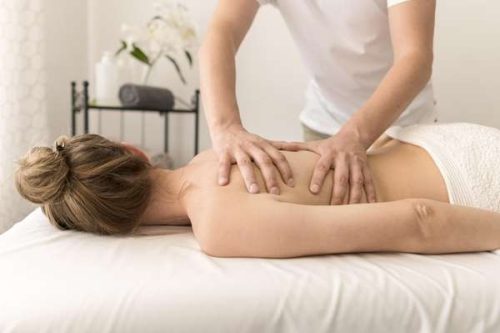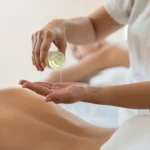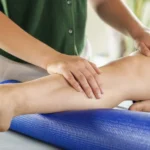When it comes to relaxation, pain relief, and stress reduction, massage therapy is a powerful tool. But what about detox? Many believe that massages “release toxins”—but is that really true? This article combines scientific insight with holistic awareness to explore what actually happens inside your body after a massage. You’ll learn what toxins (or metabolic byproducts) may be released, how massage affects your circulatory and lymphatic systems, and what you can do to support your body’s natural detoxification process.
What are Toxins?

Toxins are harmful substances that can originate inside or outside the body. They include:
- Environmental toxins like heavy metals, pesticides, and pollutants
- Metabolic waste such as lactic acid, urea, and carbon dioxide
- Synthetic chemicals found in some massage products (e.g., parabens, phthalates)
These toxins can enter the body through food, air, water, or skin contact. If not properly filtered out by organs like the liver and kidneys, they may accumulate and contribute to fatigue, inflammation, headaches, and long-term health concerns.
Table of Contents
Does Massage Really Release Toxins?
Massage does not directly “flush out” environmental toxins like heavy metals from your muscles. However, it does support the systems your body already uses for detoxification:
- Circulatory boost: Increased blood flow helps transport waste to organs like the liver, lungs, and kidneys for processing.
- Lymphatic stimulation: Massage helps stimulate lymph flow, which clears waste from tissues and supports immune function.
- Muscle manipulation: Tension and adhesions that trap metabolic byproducts are released through skilled massage techniques.
Here’s a breakdown of common substances the body may mobilize after a massage:
| Toxin | Description |
|---|---|
| Lactic Acid | Produced by muscles during activity; can cause soreness |
| Uric Acid | Protein breakdown waste excreted by kidneys |
| Urea | Nitrogen-based waste from liver metabolism |
| Carbon Dioxide | Expelled through the lungs after circulation |
| Creatinine | Muscle metabolism byproduct, filtered by kidneys |
What Happens in the Body After a Massage?
Massage therapy has a cascading effect on multiple systems:
- ✨ Improved circulation: Massage dilates blood vessels, allowing for better oxygen delivery and removal of metabolic waste.
- ♻️ Lymphatic drainage: Specialized techniques like manual lymphatic drainage can reduce fluid retention and remove toxins more efficiently.
- 🩺 Muscle relaxation: Knots and tight muscles may trap metabolic waste; relaxing them releases stored byproducts.
- 🛌 Hormonal shift: Your nervous system shifts into a parasympathetic (rest-and-digest) state, reducing cortisol and increasing endorphins and serotonin.
Common Detox Reactions After Massage
It’s not unusual to feel different after a massage—sometimes even worse before you feel better. These are known as post-massage detox symptoms:
- 😐 Mild headache
- ☕ Increased thirst or frequent urination
- 🤤 Fatigue or temporary grogginess
- 🩸 Muscle soreness from deep work
- 😍 Emotional shifts, such as unexpected crying or clarity
These reactions typically resolve within 24–48 hours and are signs your body is adjusting to the internal changes triggered by massage.
Best Massage Techniques to Support Detox
Not all massages are created equal when it comes to detox support. Here are the most effective techniques:
Lymphatic Drainage Massage
This gentle, rhythmic style targets lymph flow. It’s excellent for immune support, post-surgery swelling, or clients dealing with chronic inflammation.
Deep Tissue Massage
Using firm pressure and slow strokes, this massage targets deep muscle layers, helping break up adhesions and mobilize metabolic waste.
Swedish Massage
A full-body relaxation massage using long, gliding strokes to improve circulation and gently encourage lymphatic movement.
Trigger Point Therapy
Focuses on releasing specific points of tension in the muscle. These “knots” can store metabolic waste and cause referred pain.
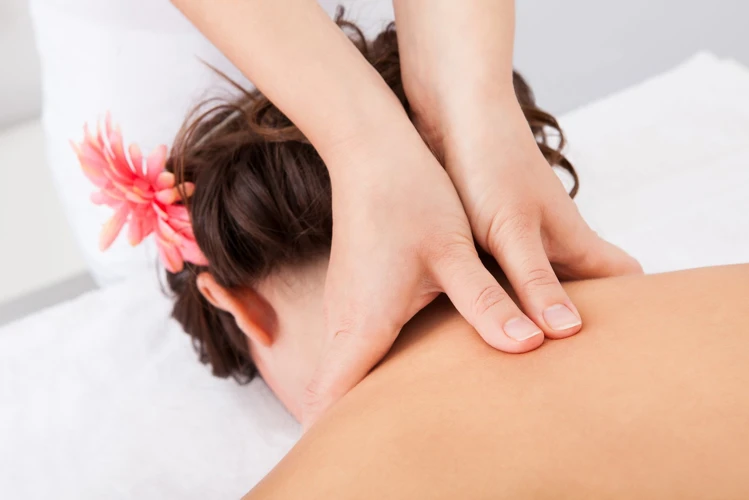
What Does the Body Release After a Massage?
Massage therapy can be a great way to reduce stress and relax your body, but many people wonder if it can also help to release toxins from their muscles. The answer is yes – massage can indeed help to flush out toxins from your body. Here are some of the toxins that your muscles can release after a massage:
- Lactic acid: A by-product of muscle metabolism, often produced during strenuous exercise. The pressure from the massage therapist’s hands can help to break it down and flush it out of the body.
- Urea: A waste product created in the liver and excreted through the urine. Massage can help mobilize urea by stimulating circulation and breaking up stagnant waste.
- Toxins from the environment: Pollutants in air or absorbed through skin can be stored in muscle tissue. Massage may help release these for elimination via the lymphatic system.
- Metabolic waste: These are general by-products of cell metabolism. The manual pressure during massage helps move these wastes from muscle tissue into the bloodstream for removal.
In addition to the toxins listed above, massage therapy can stimulate the lymphatic system, which is responsible for filtering out waste. A well-functioning lymph system is key to natural detoxification, and massage provides a gentle yet effective way to support this process.
How to Support Detox After a Massage
Maximize the benefits of your massage and help your body clear waste efficiently with these tips:
- 💧 Drink water: Staying hydrated helps your kidneys and lymphatic system eliminate waste.
- 🌾 Eat antioxidant-rich foods: Leafy greens, citrus fruits, and herbs like turmeric support liver function.
- 🏃 Engage in gentle movement: A light walk or gentle yoga can continue to boost circulation post-massage.
- 🛁 Take an Epsom salt bath: Magnesium sulfate helps draw toxins from the skin and relax muscles.
- 🛌 Get adequate sleep: Your body detoxes most efficiently at night when it’s in full repair mode.
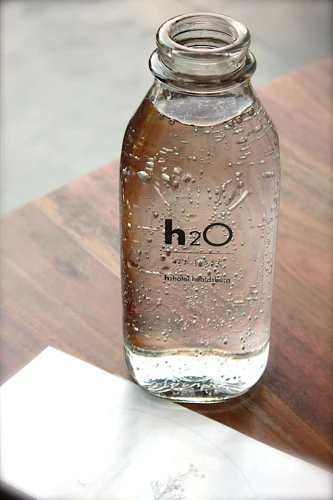
🔗 Avoid alcohol, caffeine, and processed foods after your massage to minimize burden on your detox organs.
Massage Myths About Toxin Release
Let’s bust some common misconceptions:
- ❌ You sweat out toxins during massage
✅ Truth: Sweat is mostly water and electrolytes. Toxins are primarily processed through liver and kidneys—not the skin. - ❌ Feeling sick after a massage is a sign of detox
✅ Truth: Some soreness or fatigue is common, but prolonged symptoms may signal dehydration or overexertion. - ❌ All massages release toxins equally
✅ Truth: Only specific techniques, like lymphatic drainage, are designed to directly support detoxification.

Hidden Toxins in Massage Products
Some toxins may not come from your body—but from what’s put on it.
| Toxin Type | Possible Sources |
| Parabens | Found in lotions and moisturizers |
| Phthalates | Common in artificial fragrances |
| VOCs | Emitted by scented candles, oils |
| Preservatives | Used in creams, gels, and oils |
✅ Choose fragrance-free, plant-based products to reduce exposure.
How to Minimize Product-Related Toxins
- 💼 Ask your therapist what products they use and check ingredient labels.
- 🧴 Bring your own oils if you have chemical sensitivities.
- ⚠️ Avoid synthetic scents and colored lotions.
- 🌱 Look for eco-certified or organic brands.
Is Massage Safe for People with Weakened Immune Systems?
Yes—with extra care:
- ✉️ Inform your therapist of your condition and any medications
- 🧽 Sanitization matters—ensure the space and tools are clean
- 🛏️ Opt for lighter techniques, avoiding deep tissue or sports massage
- 💧 Hydrate and rest well after the session
Massage can improve immune function, reduce stress, and aid recovery—just be sure it’s adapted to your needs.
Natural Alternatives to Massage for Detox
If massage isn’t accessible or right for you, try these supportive methods:
- 🌿 Aromatherapy – Inhalation of pure essential oils for nervous system and immune balance
- ✋ Acupressure or reflexology – Apply pressure to specific points to stimulate organ function
- 🧘 Yoga or stretching – Enhances lymphatic flow and flexibility
- 🍵 Herbal teas – Like dandelion, milk thistle, or ginger to support liver and digestion
- 🧠 Meditation – Lowers cortisol and allows your body to reset
Frequently Asked Questions (FAQ)
Does massage actually remove toxins from the body?
✅ Massage doesn’t flush out toxins directly, but it supports your body’s detox systems—like circulation and lymph flow—which help eliminate waste naturally.
What toxins or waste products are released after a massage?
✅ Common byproducts include lactic acid, urea, uric acid, creatinine, and carbon dioxide. These are naturally produced during metabolism and may be more mobilized during and after massage.
Can massage help with environmental toxins like heavy metals or pollutants?
✅ There’s no scientific evidence that massage removes environmental toxins like heavy metals. Detoxification of these substances happens mainly through liver, kidney, and cellular processes.
Why do I feel sore or tired after a massage?
✅ This is a normal response to increased circulation, muscle manipulation, and waste mobilization. It usually fades within 24–48 hours.
Do I need to drink water after a massage to flush out toxins?
✅ Yes—hydration supports kidney function and lymphatic drainage, both key to waste elimination.
Is it bad if I don’t feel sore after a massage?
✅ Not at all. Detox and benefits don’t require soreness. Everyone reacts differently based on massage type, pressure level, and individual health.
What’s the best massage for detox purposes?
✅ Lymphatic drainage massage is the most effective for detox support. Swedish and deep tissue massage also stimulate circulation and metabolic waste release.
Can massage release harmful substances into my system?
✅ No harmful effects are expected from normal massage techniques. However, using poor-quality oils or overly aggressive pressure without medical supervision could irritate tissues.
Should people with chronic illness or weakened immunity get massages?
✅ Yes—with therapist awareness and proper precautions. Always inform your therapist and stick to lighter techniques if needed.
How can I reduce toxin exposure during massage?
✅ Use unscented or organic products, avoid synthetic fragrances, and choose therapists who prioritize clean, non-toxic environments.
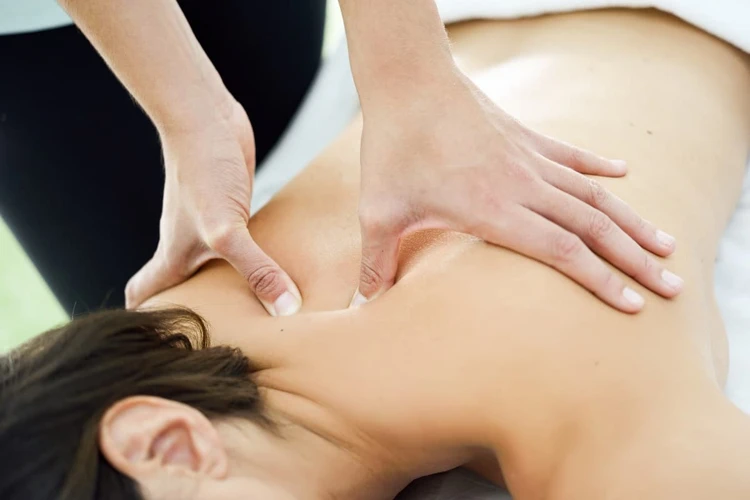
Final Thoughts
Massage therapy may not eliminate toxins in a dramatic, instant flush—but it plays a powerful role in supporting your body’s natural detox systems. Through improved circulation, lymphatic drainage, and stress reduction, massage can help you feel lighter, clearer, and more balanced.
Pair your massage with healthy lifestyle habits like hydration, clean products, movement, and rest to get the most out of each session.
Whether you’re booking a lymphatic drainage massage for post-surgery recovery or enjoying a Swedish massage for stress relief, know that your body is working with you—naturally and effectively—to maintain optimal health.
📖Also Read:
- Is Massage Safe When Sick?
- Can You Massage Your Lymph Nodes When Sick?
- Can a Deep Tissue Massage Make You Sick?
📚 References
- Massage and Toxin Exposure: A Review of the Evidence
- Skin Deep Cosmetics Safety Database
- Endocrine Disruptors
- National Institutes of Health – Massage Therapy and the Body’s Response
- Mayo Clinic – What You Can Expect from a Massage
⚠️ Disclaimer:
This article is for informational purposes only and does not constitute medical advice. Always consult with a licensed healthcare provider or certified massage therapist before beginning any new treatment, especially if you have pre-existing health conditions or concerns.

